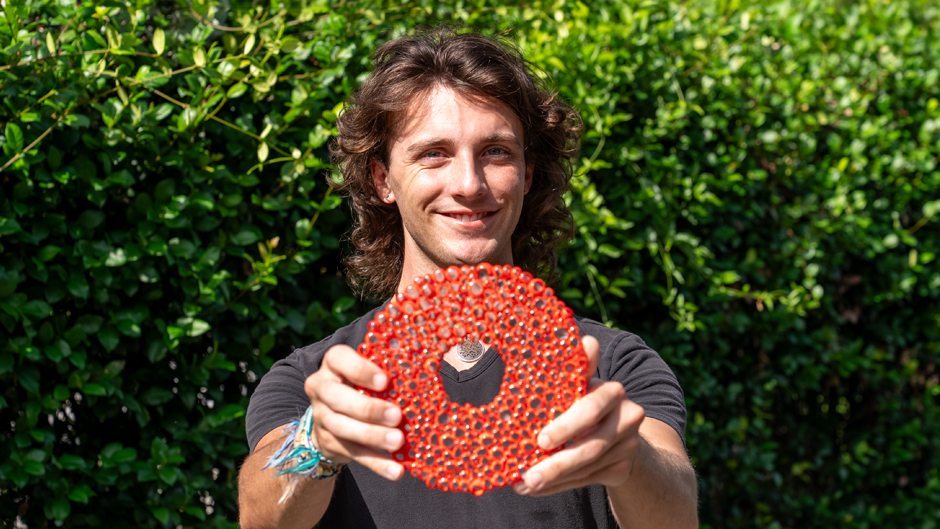It is one of the simplest animals found in nature. At just a few millimeters wide, the tiny marine Trichoplax adhaerens can easily change its shape and can split itself in half to reproduce.
Watching it transform under a microscope is a fascinating model for scientists to learn how animal tissues behave. That’s why a small team of faculty members and students at the University of Miami are exploring its properties using a different medium that shares many of the same characteristics: glass.
“The way cells migrate and tissues change shape very closely mirrors the way glass moves when it is melted,” said Carolyn Delli-Santi, a recent graduate who studied marine science and biology and minored in art, focusing on glass. “However, no biologist has had the means to put this to a test using glass.”
Glass and animal tissue can both take on three different and unique physical properties: brittleness, meaning they break or rip easily; ductility, which means they can be stretched into a wire-like shape; and elasticity, which is when materials can stretch and contract like rubber (this is true only while glass is subjected to heat). Vivek Prakash, an assistant professor of physics, often wondered if he could recreate the Trichoplax with glass to understand the limits of its tissue shape change.
“We always say tissues are like glass, but most scientists don’t have a glass shop to test the theory,” said Prakash, who specializes in biophysics research and teaches in the College of Arts and Sciences. “I was looking for the right opportunity.”
In fact, only about 70 higher education institutions in the United States have a glass shop on campus. So, as soon as he learned that the University had one, Prakash began collaborating with Jenna Efrein, an artist and senior lecturer in glass. A year ago, the stars aligned when Delli-Santi, a budding glass artist, joined Prakash’s lab.
Delli-Santi learned the intricacies of caring for a Trichoplax last summer and spent the past year working with Efrein to design glass replicas of Trichoplax, so their design reflected one of the three tissue layers in the organism’s simple body. This involved creating slender poles of glass called “cane glass.” Then, Delli-Santi and Efrein gave the cane a colored “veil” by applying colored glass before stretching it. Next, Delli-Santi spent hours cutting the glass canes into small cylinders to represent each cell and fused them into different shapes in the kiln.
“I was really interested in the idea of combining biophysics and glass; and with a lot of practice, we came up with a great proof of concept that can be used to explore the different types of strain cells experience,” said Delli-Santi, who graduated in May but has spent the summer extending the research. “From there, we have just been testing and refining the techniques.”
Biophysicists have been trying to understand how cells deform and move in the tissues of a Trichoplax because it may help reveal a greater understanding about animal tissues in general, Prakash said. There’s just one problem. Under the microscope, they are unable to stop the tiny creatures from moving. Therefore, using glass as a similar medium allows the scientists to “freeze” and study the process of tissue deformation and examine the individual cells. This process occurs each time you pull a muscle or damage your tissues somehow, Delli-Santi said. Learning more about tissue deformation could unveil critical information that could advance medical innovations for patients who need tissue grafts, trauma care, or could even help engineers create self-healing materials, Prakash pointed out.
“With this project, we are trying to understand the extreme limits of our tissues, to see how they are working on a cellular level,” Delli-Santi added.
Physics graduate student Gopika Madhu is working to quantify the cellular movements through these experiments. The team plans to share this work with other researchers in a future scientific article.
“Glass is a great material to model tissues. So with this proof of concept, we hope that more and more tissue researchers will also start working with glass,” Prakash said.
The entire project is funded as part of a University Laboratory for Integrative Science, or U-LINK interdisciplinary research grant led by Prannoy Suraneni, an assistant professor of civil and architectural engineering in the College of Engineering. Prakash is a co-investigator on the U-LINK project “Engineering Corals for Climate Change Resilience,” with a larger goal to innovate and educate students in South Florida about resilience in marine animals, like corals.
Although their work is not yet complete, Efrein said the project has been intellectually stimulating for her.
“I was very interested in learning how this organism parallels glass and enjoyed posing the question of how we would replicate the Trichoplax, based on the physics and chemistry of glass,” said Efrein, who has been working with glass for 30 years. “Hopefully, we are able to yield functional results to help science move forward.”
Eventually, the team hopes to display some of the pieces in the University’s Lowe Art Museum. Delli-Santi and Efrein also presented the project to an audience of glass artists in June at the Glass Art Society Conference in Detroit. And although Delli-Santi originally planned to become a marine biologist, this experience has highlighted the possibility of multiple career paths.
“Looking back on this project, it was shocking how it just found me—to split my time between the hot shop and the physics lab was a treat in itself,” said Delli-Santi. “This project helped show me that I don’t have to choose between art or science and there are different ways to go about doing what you want.”

